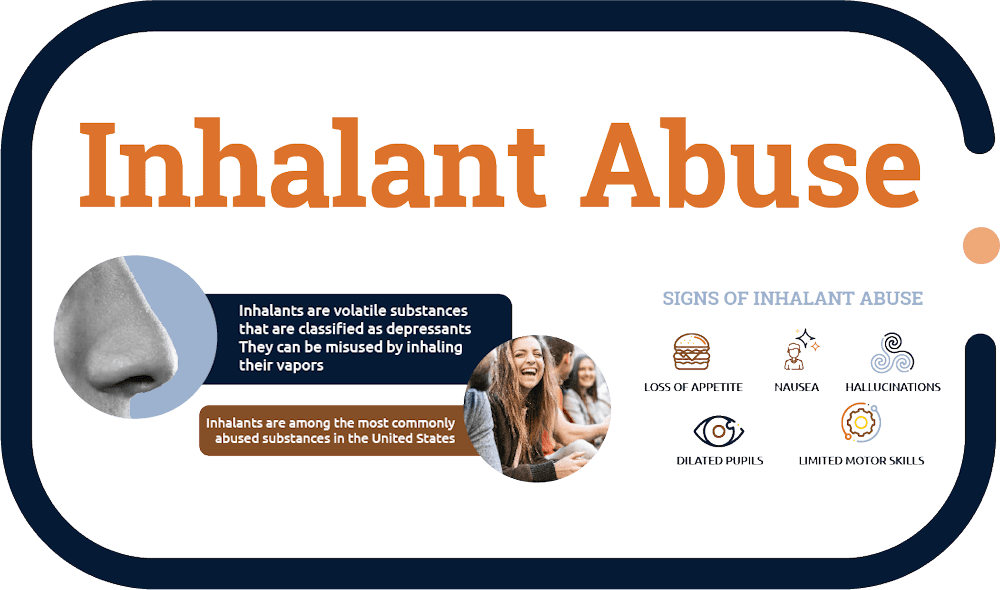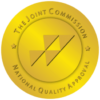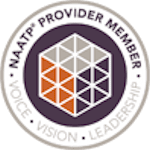Inhalant Abuse Treatment
Inhalant abuse is not as common compared to other substances such as heroin and alcohol addiction. What’s disturbing is that inhalant drugs can be found in everyday items. There are countless dangerous chemicals available, especially for children. Children must be educated about the risks of such harmful substances.
For example, whippits are some of the most popular inhalant drugs. Whippits offer a concentrated yet short-lived high. Nitrous oxide and other inhalants rob the brain of vital oxygen. The light-headed euphoria can lead to accidents, especially from a lack of motor control. Oxygen deprivation can lead to developmental issues in adolescents.
Studies have shown that informing children about inhalant abuse has decreased use. Positive results can be attributed to training life skills that embrace self-esteem and improving communication in relationships.
Inhalant drugs have a variety of names or slang terms:
- Poppers
- Snappers
- Glue
- Kick
- Bang
- Whippits
- Texas shoeshine

Jump to Section
What Are Inhalant Drugs?
Inhalant drugs can be classified as chemicals found in household or work-related products. Inhalants are absorbed rapidly in the body, usually from vapor. The vapors from inhalant drugs can produce psychoactive symptoms. In fact, there are over 1000 chemicals that can make inhalant abuse possible. The peak age for inhalant abuse is between 14-15.
The short term side effects of inhalant drug users experience:
- Slurred speech
- Blurred vision
- Headaches
- Dizziness
- Excitability
- Loss of coordination
However, inhalant abuse has been reported as early as 5-6 years old. Inhalant abuse tends to decline by the ages of 17 to 19. Adulthood abuse of inhalant drugs is not uncommon, with more cases coming from men than women. Inhalant abuse typically occurs in isolated regions.
Inhalant drugs are executed through the following:
Snorting: usually means using a tube to inhale the substance or directly sniffing from the source.
Huffing: typically practiced by coating a rag or cloth with the substance before inhaling.
Bagging: most common method among abuse which includes using bags to inhale the volatile substances.
What Are the Classes of Inhalant Drugs?
Aerosols
- Spray paints
- Spray deodorants
- Hair spray
- Vegetable oil spray
- Fabric protector spray
Solvents
- Paint thinners
- Paint removers
- Degreasers
- Gasoline
- Rubber cement
- Lighter fluid
- Glues
- Nail polish removers
- Dry cleaning fluids
- Felt tip markers
Gases
- Chloroform
- Halothane
- Nitrous oxide (Found in whipped cream canisters)
- Butane lighters
- Propane tanks
- Refrigerants
What are Nitrites?
Nitrites are chemicals that you’d find in leather cleaner, liquid aroma, and room deodorizers. Nitrites directly impact the central nervous system. Nitrites are popular for sexual enhancement due to their relaxing effect on the muscles. Nitrites are referred to as “poppers” or “snappers.”
How Are Inhalant Drugs Addictive?


The short-term side effects of inhalant abuse can deceive the person, considering that inhalant drugs can enforce lasting damage to the body. If you notice alarming or suspicious behavior from a friend or loved one, they might be struggling with a substance use disorder. Staging an inhalant drug intervention should be a viable option.
Inhalants generally contain more than one chemical, with some remaining in the body for long periods. Inhalant abuse can cause damage to the nerve fibers in the brain, which causes issues with communication.
Inhalant drug abuse can cause brain cell damage from the lack of oxygen. This can alter the function of the hippocampus, the region of the brain responsible for memory and learning. If the cerebral cortex is damaged, the person will have trouble problem solving and forward thinking.
A Brief History of Anesthetics
If you’ve ever undergone surgery or procedure that required pain reduction, an anesthetic would have been used. Medication to treat pain has endured a long marathon, through regulations and discoveries. The impact has revolutionized the way we treat patients.
An anesthesiologist is skilled in various tools for diminishing pain, awareness, and movement. In the early 1800s, analgesia dentist Horace Wells discovered the use of nitrous oxide during a dental extraction.
His partner, William T.G. Morton, aided his demonstrations on the effects of nitrous oxide. With some help, Morton refined his technique to extract a molar from a patient.
The nitrous oxide in blood causes blood to diffuse into air-filled cavities faster than it can be absorbed. 78% of the air we breathe is nitrogen. Nitrous oxide is unique, considering it remains in gaseous form at ambient room temperature. Liquid solubility is what determines the potency of nitrous oxide.
What Are Signs of Inhalant Abuse?
The signs of inhalant abuse may not be as apparent, but keep your eyes peeled on certain patterns and behaviors. It’s vital that two or more of the signs sync up with the actions of the person abusing inhalants.
The signs of inhalant abuse may include:
- Chemical odors on their breath or clothes
- Bloodshot or dilated eyes
- Paint or other stains on their hands, fingers, or clothes
- Lack of interest in activities
- Decrease in appetite
- Poor performance in school or work
- Runny nose or nosebleeds
- Slurred speech
What makes inhalant abuse difficult to spot sometimes is the fact these substances can be purchased legally. Inhalant abusers could be discreet about the amounts taken and finding spots to hide them. You might notice small changes in their mood or behavior. Young children and teens make up a large percentage of inhalant drug abuse.
Sudden death sniffing syndrome is possible. Sudden death sniffing syndrome can cause the body to enter cardiac arrest, after an accelerated heartbeat.
Inhalant abuse tends to parallel those with a history of physical or sexual abuse, mental health symptoms, and lower-income rates. Those in rural communities or high poverty rates tend to resort to inhalant drugs.
Trained medical staff must properly screen those with an inhalant abuse disorder. Since inhalants can’t be discovered in a urine test, clinical diagnosis needs a different approach. Clinical testing could indicate elevated liver enzymes. Blood and other tissues can be inspected by gas chromatography.
What Are Withdrawal Symptoms of Inhalant Abuse?
Withdrawal symptoms from inhalant abuse typically settle in 24-48 hours after use has stopped. The intensity of the withdrawal symptoms will vary based on the type of inhalant and frequency of use. The withdrawal symptoms of inhalant abuse can last for 2-5 days. Some individuals may not experience withdrawal symptoms.
The withdrawal symptoms of inhalant abuse are:
- Irritability or mood swings
- Poor memory
- Difficulty concentrating
- Sweating, rapid heartbeat
- Hand tremors
- Insomnia
- Cravings
- Anxiety
- Depression
The first two days of inhalant withdrawals can reach peak intensity. The psychological symptoms will begin to form, although, after 2-5 days, the symptoms should begin to subside. After over a week, the withdrawal symptoms should nearly fade away.
The cravings for inhalants may linger after the bulk of withdrawal symptoms pass. This is recognized as post-acute-withdrawal syndrome. PAWS can last up to 18-24 months after use has stopped. Your gender, body weight, type of inhalant, length of time abused, and medical history can play a role in the depth of inhalant withdrawal symptoms.
The long-term side effects of inhalant abuse could cause:
- Memory or learning problems
- Weakened immune system
- Brain damage
- Liver, kidney, or lung damage
- Personality changes
- Hallucinations
- Difficulty speaking or solving problems
- Vision complications
- Motor impairment (Muscle spasms, walking problems)
Can I Overdose from Inhalant Abuse?


A paramedic would have to stop the seizure or your heart from stopping. However, there are no specific treatments to challenge the effects of inhalant overdose. That’s why it’s crucial to seek help if you are on the deep end of inhalant drug abuse.
Signs of a inhalant abuse overdose reveal:
- Vomiting
- Nausea
- Chest pain
- Seizures
- Blacking out
What Are Treatment Options for Inhalant Abuse?
If you’ve decided to enter treatment for a inhalant dependence, inhalant abuse treatment could be an efficient solution. Behavioral health treatment has been shown to be quite effective at treating addiction. Research the facility you intend to admit into for addiction treatment.
Within addiction recovery, relapse is a common theme. You may feel stuck in the limbo of inhalant abuse. The physical toll it has left an imprint on you. There’s a chance for you to recover through a series of tough but enlightening decisions. Maintaining sobriety requires immense patience and practice, through the help of a strong support system.
Detox
Detox for inhalant abuse would be the first phase of your treatment. Detox is the fundamental stage of removing toxins from the body. To combat withdrawal symptoms, you can expect to receive medications to alleviate them. Medical staff will evaluate your medical history to determine what’s best. Detox can last 7-10 days, however, longer if your case requires it.
Inpatient Treatment
Inpatient treatment is a 24/7 intensive program. You can expect to receive comprehensive care, from psychotherapy to medication management. The staff is there to answer any questions and provide detailed information. 30 days is the recommended length of time for treatment, however, 90 days is the most optimal.
Patients will undergo individual and group therapy. Each facility will vary with its programs and amenities. The cost of treatment will be reflected in the location and services offered by the inpatient treatment program.
Outpatient Treatment
Outpatient treatment programs can provide you with a flexible opportunity to receive treatment. The average length of time for treatment is 30 days. Psychotherapy is offered through individual, group, and family therapy. You’re expected to attend sessions that vary from 4-6 hours, five days a week.
IOPs (Intensive Outpatient Treatment Programs) are an intensive approach to treat mild to relatively severe cases of addiction. The enhanced structure of the treatment and flexibility would serve those who don’t have a rich support system. In an IOP, patients are expected to attend sessions from 6-8 hours, five days a week.
Dual Diagnosis Treatment
Dual diagnosis treatment is becoming a welcome source of recovery for substance abuse. There’s an alarming connection between individuals with a mental health and substance use disorder. Mental health symptoms often drive people to self medicate with substances. On the other hand, those struggling with substance use disorders are met with mental health symptoms.
Treatment for both disorders is demanded in order for a full recovery. Addiction is a complex disease, which requires support from all angles. Chronic relapse can prevent a person from reaching their goals. Evidence-based therapies such as CBT (Cognitive Behavioral Therapy) can offer you a chance to rewrite your compulsive behaviors.
Case Management
Case management can provide a discreet tool for addiction recovery. Typically, a counselor or social worker is assigned to your case. They will create an outline for your recovery goals and introduce techniques to manage your recovery. An evaluation of your medical, family, and addiction history will be done to determine your path. This could serve adolescents who may have experienced inhalant drugs for the first time.
Support Groups
Support groups are a great way to understand the nuances of the addiction process. Support groups are moderated by a counselor or social worker. Each member can participate in the healing journey, offering their experiences. Sharing is encouraged to build empathy and find grace in your compulsive behaviors.
Support groups can be specific, such as AA (Alcoholics Anonymous). The sense of community can bring you more insights into challenges that you could face. The 12-Step Program is a set of guidelines for recovery through the means of a higher power.
Northern Illinois Recovery
Inhalant abuse can paint a murky cloud of confusion and potentially life-threatening outcomes. Substance abuse is a growing issue in the United States and globally. Northern Illinois Recovery is determined to provide excellent care and attention to your needs. Quality addiction treatment is a calling card into the lifetime of sobriety. Those who remain active in the continuum of care have projected positive outcomes. If you or a loved one are struggling with addiction, contact us today.
Testimonials
This is the best treatment center I’ve ever been to. The staff is amazing and really cares about the clients. They go out of their way for the clients’ wellbeing. This program is the only one I’ve been too that prepares you for the real world and how to be a productive me ever of society. They allow you to work there once your in the 3rd phase and set up a solid after-care plan. I highly recommend this place.
Camille Casey
Even after issues with my insurance Darek Horan and Chris Reed made sure I got in to get the treatment needed. The Clinical and Housing staff they have at NIRC is phenomenal, a dream team, if you will. They have set the foundation for my sobriety, I have 5 months sober going strong. I couldn’t have asked for a better experience in treatment or a better person to run it. Chris Reed is the MOST involved person running a treatment center I’ve ever seen and I’m blessed to have witnessed this program blossom. I am now part of the alumni program and continue to be involved in where the treatment center is going and I’m excited to be part of its future in the McHenry County area.
Gabriel Irace
Super grateful to be apart of a team that goes above and beyond to tackle any and all needs of all the clients at our facility. No matter what hour of the day there is always someone available to assure that individual needs are constantly being met, including intakes. The doctor and nurse at NIR care so deeply about ensuring that every client is safe and healthy. The psychiatrist has a rockstar team and ensures every individual is also addressing any other mental health needs! I am also so happy to work for a facility that provides MAT safely and long term as well. I enjoy working alongside a team of people who want nothing but success and sobriety for their clients & ensuring they are set up for just that!
Frankie Casillas
I have been at this treatment center for over two months and the staff is amazing and truly cares about each and every client and their recovery. The groups have a ton of useful information that have excelled my recovery ten fold. All of the staff members will go out of their way to make sure you have everything you need to have the best road to recovery that’s possible for yourself. I’m so grateful to NIRC for helping me to recover from a seemly hopeless state of mind and body.
Thomas Jackson
I wouldn’t have been able to get sober without coming to NIRC. The staff here is incredible and has helped me better my life. While in treatment I was able to build a huge support network in the area. They helped me apply for jobs, look for sober living, get a sponsor, rebuild relationships with family and friends. Living in their housing helped me build a daily routine and keep structure in my life. I’ve been to several treatment centers in my life and I would recommend Northern Illinois Recovery Center over any other facility.
Jesseeka Garrett
I was a client here, and the staff really seem to actually care about the clients. They introduce us to the program of AA and push us to do the right thing, which is a huge plus. Definitely helped me a lot, and I’m very grateful for this place & everyone that works here. Not only do they introduce you to AA, but they have many groups that are extremely beneficial, and help you learn how to cope with your emotions, & process traumatic things.
Julie Brandseth
NIRC is filled with staff who truly care about their clients and understand what they’re going through. They help their clients every step along the way teaching them how to maintain long-term sobriety, and if a problem comes up they address it immediately and fix it. Their housing and clinical building are all clean, modern, and well taken care of. In my experience I’ve never been to a place as nice with staff who cares as much as they do, I credit them a lot for my sobriety now and the progress I’ve made.
Kyle Sweeting
Get the help you need at Northern Illinois Recovery!
855.458.1739
Addiction Therapy Services at Northern Illinois Recovery


Licensed Physician and Surgeon
Dr. Beth Dunlap, a board-certified addiction medicine and family medicine physician, and is the medical director at Northern Illinois Recovery Center. She is responsible for overseeing all the integrated medical services at both campuses. Beth completed medical school, residency, and fellowship at Northwestern University, where she continues to serve on the faculty as a member of the Department of Family and Community Medicine. She has extensive experience in addiction medicine at all levels of care, and her clinical interests include integrated primary care and addiction medicine, harm reduction, and medication-assisted treatment.



